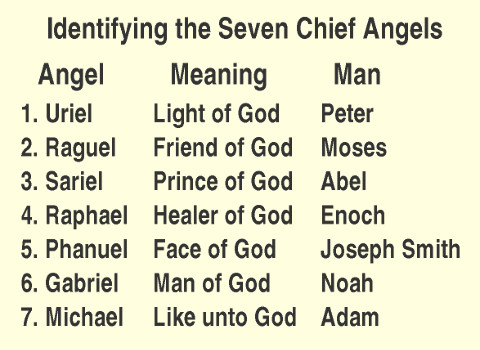
by John P. Pratt
25 Jan 2020, 1 Heshvan (UH), Sea-Goat (S), Hercules (US)
©2020 by John P. Pratt. All rights Reserved.
|
1. Seven Chief Angels 2. Biblical Patriarchs 2.1 Abraham 2.2 Isaac 2.3 Jacob 2.4 Joseph 2.5 Eber 2.6 Paul 3. The Big Four 4. Matriarchs 4.1 Mary 4.2 Sarah 4.3 Asenath 4.4 Esther 5. Conclusion Notes |
The concept of multiple mortal probations[1] suggests the probability that the seven chief angels have lived as mortals on earth more than one time each. This is the fourth article in a series which proposes possible correlations between those seven angels, various religious leaders, and constellations which might represent them. The first article proposed that in the 7x7 table of 49 constellations, each column represents one of the seven angels and the seven constellations in each column may each represent one of their the mortal lives. Moreover, it went on to identify which constellation represented what formerly was considered to have been the only mortal life of each angel (see Table 1).[2] It is recommended to read both of those articles before this one, as it builds on them.
 |
This article attempts to identify the constellations associated with the angels who were the great patriarchs of the Bible, such as Abraham, Isaac, and Jacob, and some of the great women of religious history. It proposes ten more constellations which most likely represented them.
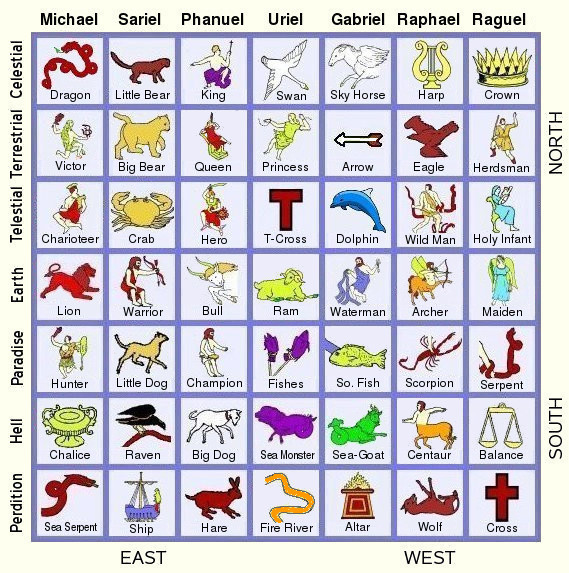 |
Figure 1 shows the 7x7 table of 49 constellations, with the name of one of the seven chief angels at the head of each column. This table is actually a map of the heavens as seen from the northern hemisphere looking south. Thus it has the compass directions listed on the right and bottom. Moreover, each row represents a level of spirituality, with the top rows being the most spiritual or heavenly.
Figure 2 shows the same table without the names of the constellations and in the place of those names are the names of the first twenty-one mortal men identified so far in all three earlier articles who were one mortal probation of each of those angels.
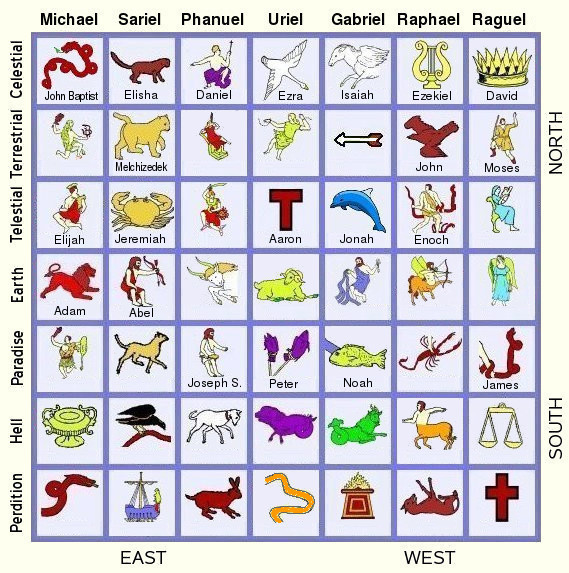 |
Section 1 was a review of the first three articles in this series. Now we turn to identifying ten more constellations associated with important patriarchs and their wives.
Let us now proceed to propose constellations to represent those angels who have lived a mortal probation as one of the great patriarchs of the Bible. It is important to understand that as we do so there are huge implications included in making these proposals. In particular, each one means that these great men were not just great patriarchs, but that they were actually separate mortal probations of the seven chief angels of God.
One justification for being bold enough to suggest this is that since it has been discovered that the 49x49 constellation table indeed does represent different men, because the Bible itself implies that John the Baptist was indeed a new probation for the great prophet Elijah, and that they were both incarnations of the archangel Michael. That opens the door for others of those prophets to have been separate probations of the other six chief angels. Let us see if the symbolism of the constellations figures does indeed tie to the lives of the patriarchs.
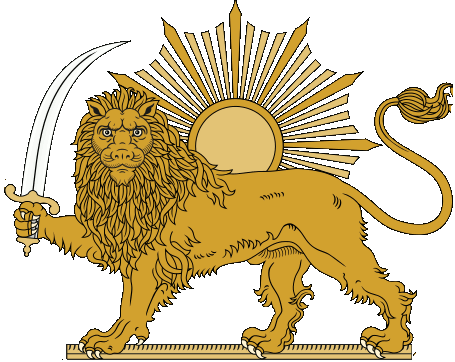 |
So where exactly does Abraham fit in? Surely he should have a constellation if so many with others in lesser roles have one. Using the same rule which has been used in all three of the earlier articles in this series, it is necessary to find an known event in his life which could be immortalized in a constellation.
 |
The symbol of ancient Persia (now Iran) was the lion. The constellation called Hercules is almost always depicted with him wearing a lion skin because one of the twelve Herculean tasks was to kill the Nemean lion. That myth may indeed have symbolized conquering the King of Persia, and three other kings, with just his household servants. That was an amazing deed.
It is here proposed that Abraham is represented by the constellation of Hercules.[5]
 |
Exactly one of all of the constellations represents a sacrificial offering. It is the Sea-Goat (Capricorn). The fact that it is from the sea and a goat rather than a lamb, probably has to do with the fact that, like all twelve of the zodiac figures, it also represents Jesus Christ, who was executed because he was judged to be evil, using powers from below.
Thus, it is proposed that the constellation representing Isaac is the Sea-Goat (Capricorn).
The constellation for Jacob is also easy to determine, once the event is recogized. The event was the birth of Jacob. At his birth with his twin brother Esau, he grabbed the heel of twin brother who was born first. The astute midwife noticed this exceedingly rare event and thus he was named "Jacob". That means "heel grabber" from the second half of his name, 'aqab using English letters for Hebrew sounds (Strong word #6117), meaning heel.
That Hebrew word for "heel" only differs by one letter for the Hebrew word for "Scorpion", which is 'aqrab (Strong word #6137). In my work decades ago, long before it because clear recently that each constellation represent a mortal man's life, because of this it was known that the Scorpion was a symbol for Jacob.
Thus, it is proposed that the constellation representing Jacob is the Scorpion (Scorpius).
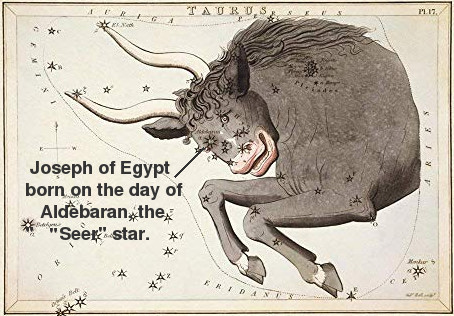 |
The symbolism of the Bull in the life of Christ is that of the Lord of Hosts, usually meaning army general. That is a close enough match for Joseph, who became the Prime Minister of Egypt.
Thus, it is proposed that the Bull (Taurus) is the constellation representing the patriarch Joseph.
Eber is in the line of patriarches between Noah and Abraham. He was of the era when the patriarchs were transitioning from living nearly 1,000 years (Noah lived to 950) to about 120 years (Joseph lived to 110). Eber lived for 464 years, whereas his son Peleg lived only a mere 239 years (Gen. 11:16-19). The real point here is Eber was very righteous, unlike all of the others between Shem and Abraham, and he lived so long that he and Shem had an academy that trained both Isaac and Jacob in the ways of the Lord, especially Jacob after he fled from his brother Esau (Jasher 24:17, Jasher 29:11).
The sacred calendars witness that Eber and Jacob were very closely linked, which is not surprising if Eber was Jacob's teacher. All of this is to say the Eber might be worth considering as a worthy candidate to own a constellation.
So what is it that is unique about Eber? What is he remembered for? About the only thing in the Bible is that the "Hebrews" are named for him. The name "Eber" is the same as "Heber", without the "H" pronounced. All Hebrews are his descendants, including "Abram the Hebrew" (Gen. 14:13).
So what constellation might show that concept in the stars? The Biblical symbolic animal to represent the Hebrews (or technically, the Israelites) is the sheep. Jesus was sent only to the lost sheep of Israel (Mat. 15:24).
Thus, it is here proposed that the Ram (Aries) in the zodiac is the constellation for Eber.
 |
Paul is not considered one of the patriarchs, but is being included in this section as an afterthought, because the article about Peter, James, and John was part of the one about priesthood. The importance of Paul came during my research about whom the other zodiac constellations might represent.
So what is unique about Paul? The vision on the road to Damascus comes to mind immediately, but many others also had a vision of Christ, such as Stephen (Acts 7:55-56).
So what is unique about Paul? Is it not what was just mentioned about him setting out by himself to teach all of Europe and Asia (Turkey), starting churches all along the way? He was a Jew (house of Benjamin, Romans 11:1) sent to gentiles. It was he who convinced the church leaders in Jerusalem not to require circumcision of new gentile converts (Acts 15:2).
Is there a constellation that might represent someone who is in a way half Jew and half Gentile? The answer is yes, there is! The Archer (Sagittarius) is a centaur, being half horse and half man. He is a warrior for God because he is shooting at the Scorpion (who in this case is evil, not a righteous judge).
Paul himself makes the point that he turned himself into either Jew or gentile depending who he was with. That is, when he was preaching to Jews, he was a Jew, but when he was preaching to gentiles, he became a gentile, so that he might convert them (1 Cor. 9:20-21). Is that not a perfect match for a centaur, being half man and half horse?
Thus, it is proposed that the apostle Paul is represented by the zodiac constellation of the Archer (Sagittarius).
In a recent article, it was proposed that the seven chief angels are actually divided into three groups: there are four in the most important group, two in the next, and one in the last group.[6] Let us consider all of the priesthood leaders, prophets, and patriarchs now as divided into those three groups, to check for self-consistency.
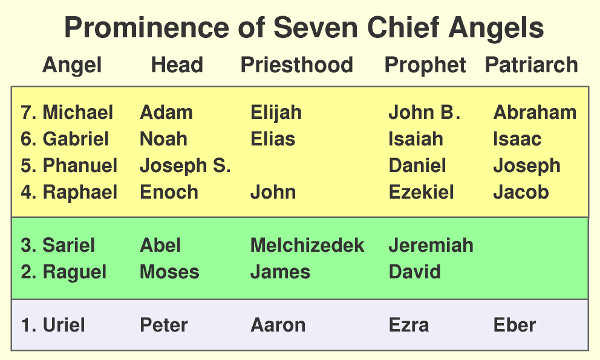 |
Table 2 shows all of the results so far grouped with the four highest level angels at the top. It is seen that the grouping is consistent with the usual perception of which are the most important patriarchs and prophets, as well as dispensation heads and priesthood leaders. The latter two categories as less well ordered in the public mind. The main point is that the assignment to constellations was done according to unique attributes, but the end result is that they ended up grouped with the four most important angels with the four most important roles.
Now let us turn to the great matriarchs and other women in Biblical history. There are only four women shown in the constellations. This section comes after the section on the Big Four angels, because it appears that the four women shown in the heavens represent the wives of the Big Four chief angels. That is, those four constellation represent Sarah, Rebekah, Rachel & Leah[7], and Asenath.
It is proposed that one female constellation can represent several mortal women, unlike one male constellation representing only one mortal man. In other words, because there are only four constellations for great women, each does multiple duty and hence also represents other great women of history, such as the Miriam, the sister of Moses and Queen Esther. The name shown on the 7x7 constellation table will match the life during which the event shown in the figure was lived.
.jpg) |
At this point, something needs to be made clear about both the Virgin Mary and also Mary Magdalene. Both of these women are in a class above all of the seven angels and their wives about which this series of articles concern. Mary Magdalene was the wife of Jesus Christ. She and Jesus are both above all of these angels. Even as all of the twelve constellations of the zodiac symbolize Christ, so also do all four of the women's constellations represent Mary Magdalene. One witness of this is that the day of her death occurred on the brightest stars in two of them. Her death date was on the day of the star named the "Holy Son" in the constellation of the Infant Prince (Coma) on the Star Calendar, and also on the star day of the "Seed of Woman" (Spica) on the Uniform Star Calendar. Although she had a daughter named Sarah with Jesus, after the Crucifixion she married His brother Joses, according to the law of Moses, and gave to Jesus a male heir to inherit the throne of David.[8]
The Virgin Mary was the wife of God, who condescended to come to earth to bear his Holy Son (1 Nephi 11:18, 26-27). She is above even Jesus and Mary Magdalene. The huge constellation of the Maiden (Virgo) clearly refers principally to her, but that is above the scope of this article.
As with Mary Magdalene, all four of the constellations refer to both of these Marys. They both gave birth to a holy son, they both were queens, and they were both "chained princesses" like the Chained Princess Andromeda because both were incarcerated shortly after the martyrdom of James the Apostle, after which they fled to Europe.[9]
Keeping all of that in mind and focusing on other women, this constellation also appears to represent several others. First, it is Rachel, who had much in common with the Virgin Mary. For one thing they both gave birth to a son in Bethlehem (Gen. 35:18-19).
Another woman that is likely represented by this constellation is Miriam, the sister of Moses, whose name is Hebrew for "Mary". It is probably also that for other women named Mary, such as Mary the mother of James the Less (Mark 15:40).
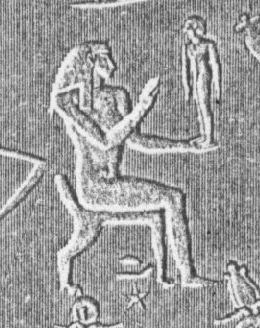 |
 |
The constellation of the "Chained Princess", or simply "Princess" in my work, fits Asenath and none of the other wives of the patriarchs.
 |
The happy ending was that an angel, which one account said looked like Joseph ("Phanuel" means "Face of God"), appeared to her and said it was okay to marry Joseph because his god was the one true God! She was immediately converted to the worship of Jehovah, but swooned into deep sleep on her bed. Then the angel appeared to Joseph and said it was okay to marry Asenath, because she was really his niece, daughter of his sister Dinah and Shechem, and hence of the chosen lineage. She had been rejected by her uncles as an infant for having been born out of wedlock. They left her for the slave traders to take to Egypt, where she was adopted by the childless high priest. Then the angel said that Joseph might wish to break into the tower to claim his bride because she was unconscious. He did so, kissed her, she awoke, and they lived happily ever after![10]
 |
As for other women whom this constellation might also represent, two come to mind as indicated by the sacred calendars. First, Dinah, daughter of Jacob and mother of Asenath, was born on the star day "Queen" (Beta Cas) one of the bright stars in the constellation of the Queen. Second, because the other three lady constellations appear to be the wives of the other patriarchs, this constellation would also represent Rebekah, wife of Isaac. This identification is less certain because no direct link between her and this constellation has been noticed. It is made strictly by deduction that the four women are all matriarchs with the four main patriarchs. More research is needed on all of the women!
This article is the fourth in a series which attempts to identify constellations which represent the mortal lives of some of the seven chief angels. This one focuses on those which were great patriarchs and matriarchs of the Old Testament.
By following the requirement that something during the mortal life should tie in some way to the constellation, ten new constellations were added to the previously found twenty-one, for a total of thirty-one. Those new ones include the following men: Abraham is the Victor (Hercules), Isaac is the sacrificial Sea-Goat (Capricorn), Jacob is the Scorpion (Scorpius), Joseph is the Bull (Taurus), Eber is the Ram (Aires), and St. Paul the Apostle is the Archer (Sagittarius). There are also four women who probably represent the four matriarchs: Mary is the Maiden (Virgo), Sarah is the Infant Prince (Coma), Asenath is the Chained Princess (Andromeda), and Esther is the Queen (Cassiopeia). These ten new additions are shown in red in Figure 3.
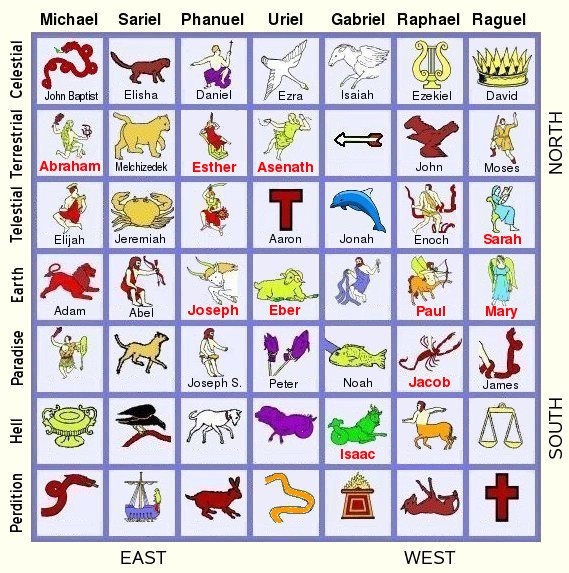 |
These constellations were truly inspired when revealed long ago to Enoch the Prophet by the angel Uriel. They help us to understand the foreknowledge and depth of the plan of salvation provided for us by a loving God.